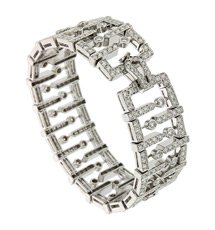The Chalk Emerald
The Chalk Emerald was unearthed in Columbia, weighing in at a hefty 38.4 carats, or 7.68 grams. It possesses a vivid green hue, along with the jardin inclusions so admired in emeralds. After this jewel was mined, it traveled to the Baroda State in India, where it became an heirloom piece for the Maharani’s family.
In the twentieth century, the emerald found its way to the Harry Winston Company, where it was trimmed down to 37.82 carats (7.564 grams) and set into a ring surrounded with diamonds. The ring was purchased by Mr. and Mrs. O. Roy Chalk, who gave the emerald its name. In 1972 the couple donated the ring to the Smithsonian Natural History Museum, where it remains on display.
Hooker Emerald
This jewel emerged from Columbia, most likely during the 16th and 17th centuries. It weights a generous 75.47 carats and boasts remarkably few inclusions for an emerald of its size. The beauty of this gemstone caught the eyes of the Ottoman Empire’s ruling family, who made the emerald part of their crown jewels. There, the stone was most associated with the empire’s last Sultan, Abdul Hamid II, who was fond of wearing the emerald.
Tiffany and Company purchased the jewel during an auction in 1911, and set the emerald into a tiara. Despite a boost of publicity at the 1940 New York World’s Fair “House of Jewels” exhibit, the tiara remained unsold. In 1950, the emerald was reset into the center of a diamond and platinum brooch. This updated look appealed to Mrs. Janet Hooker, who bought the piece in 1955 and gave the stone its name. The Hooker Emerald is available for public viewing at the National Museum of Natural History.
Patricia Emerald
The Patricia Emerald hails from Chivor, Columbia, where it was mined in 1920. Unlike other famous emeralds, this jewel was named in honor of the mine proprietor’s daughter rather than a later owner. One of the more notable features of this rough is its 632 carat mass. Few massive emeralds are allowed to remain uncut. Those who wish to see this jewel can find it at the American Museum of Natural History’s Morgan Memorial Hall of Gems.
In addition to its size, this emerald is notable for its shape. On the molecular level, emeralds are shaped into hexagonal lattice patterns. This structure is reflected in the rough crystals, which often resemble six sided sticks. The Patricia Emerald stands out from this pattern, displaying a rare twelve sided form.
Devonshire Emerald
As with many jewels, the larger the emerald, the rarer and more valued they become. Most emeralds on the market fall along a broad range, with 1-5 carats popular for central stones, jewels 20 cts and higher for specialized pieces, and gems as little as .02cts for sale. All of them are dwarfed by the Devonshire Emerald, a rough stone weighing 1,383.93 carats.
Like many emeralds, this rough emerged in Columbia, from the Muzo mine. Though the gemstone spent time in the possession of Pedro I, the Emperor of Brazil, the jewel got its name from its next owner, the 6th Duke of Devonshire. The emerald has spent a lot of time in the limelight, enjoying places of honor at the 1851 London Great Exhibition, and at the United Kingdom’s Natural History Museum in 2007.





